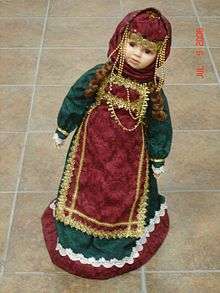Armenian dress
The dress of the Armenians (Armenian: տարազ, taraz;[1]) reflects a rich cultural tradition. Wool and fur were utilized by the Armenians and cotton that was grown in the fertile valleys. Silk imported from China was used by royalty, during the Urartian period. Later the Armenians cultivated silkworms and produced their own silk.
| Part of a series on |
| Armenians |
|---|
 |
| Armenian culture |
|
Architecture · Art Cuisine · Dance · Dress Literature · Music · History |
| By country or region |
|
Armenia · Artsakh See also Nagorno-Karabakh Armenian diaspora Russia · France · India United States · Iran · Georgia Azerbaijan · Argentina · Brazil Lebanon · Syria · Ukraine Poland · Canada · Australia Turkey · Greece · Cyprus Egypt · Singapore · Bangladesh |
| Subgroups |
| Hamshenis · Cherkesogai · Armeno-Tats · Lom people · Hayhurum |
| Religion |
|
Armenian Apostolic · Armenian Catholic Evangelical · Brotherhood · |
| Languages and dialects |
| Armenian: Eastern · Western |
| Persecution |
|
Genocide · Hamidian massacres Adana massacre · Anti-Armenianism Hidden Armenians |

ِA doll in Armenian dress.
The collection of Armenian women’s costumes begins during the Urartu time period, wherein dresses were designed with creamy white silk, embroidered with gold thread. The costume was a replica of a medallion unearthed by archaeologists at Toprak Kale near Lake Van, which some 3,000 years ago was the site of the capital of the Kingdom of Urartu.[2]
See also
- Armenian culture
- Armenian dance
References
- Western Armenian pronunciation: daraz
- The Costumes of "Armenian Women” and “ARMENIA Crossroads of Culture- by Anahid V. Ordjanian
This article is issued from Wikipedia. The text is licensed under Creative Commons - Attribution - Sharealike. Additional terms may apply for the media files.